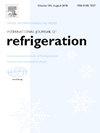抑制后向传热提高离心压缩机性能
IF 3.5
2区 工程技术
Q1 ENGINEERING, MECHANICAL
International Journal of Refrigeration-revue Internationale Du Froid
Pub Date : 2025-04-21
DOI:10.1016/j.ijrefrig.2025.04.020
引用次数: 0
摘要
本研究通过三维流体模拟结合共轭传热(CHT)方法,建立了离心式压缩机内部空气与固体壳体之间的综合换热路径。结果表明,固体壳体与空气之间的传热显著,导致固体壳体内的反向传热。与没有固体外壳的理想情况相比,这种反向传热导致效率降低1.42%,总压比降低3.08%。优化机壳结构,增加热阻,有效抑制反向传热,提高压缩机性能。此外,通过采用一体化冷却方案,可以显著减少甚至消除逆向传热。使用水冷壳,从下游叶轮通道和扩散器区域传递到固体壳的热量被冷却水带走,防止反向传递到上游固体壳并加热空气。与原型相比,集成冷却的固体外壳温度显著降低,效率提高了2.05%,压力比提高了4.35%。本研究不仅提高了对离心式压缩机传热特性的认识,而且提出了一种抑制固体壳体内反向传热的设计方法。这大大提高了压缩机的性能,具有重要的工程应用价值。本文章由计算机程序翻译,如有差异,请以英文原文为准。
Performance improvement of centrifugal compressors by suppressing backward heat transfer
This study establishes a comprehensive heat transfer pathway between the air and the solid housing within the centrifugal compressor through three-dimensional fluid simulations combined with the Conjugate Heat Transfer (CHT) method. The results indicate significant heat transfer between the solid housing and the air, resulting in backward heat transfer within the solid housing. Compared to the ideal scenario without a solid housing, this backward heat transfer leads to a 1.42 % reduction in the efficiency and a 3.08 % reduction in the total pressure ratio. Optimizing the housing structure to increase thermal resistance effectively suppresses backward heat transfer, improving compressor performance. Furthermore, by adopting an integrated cooling scheme, backward heat transfer can be significantly reduced or even eliminated. With a water-cooling housing, the heat transferred to the solid housing from the downstream impeller passage and diffuser region is carried away by the cooling water, preventing reverse transfer to the upstream solid housing and heating the air. Compared to the prototype, the temperature of the solid housing with integrated cooling significantly decreases, resulting in a 2.05 % increase in efficiency and a 4.35 % increase in the pressure ratio. This study not only enhances the understanding of the heat transfer characteristics of centrifugal compressors but also proposes a design method to suppress backward heat transfer in the solid housing. This significantly improves compressor performance and has important engineering application value.
求助全文
通过发布文献求助,成功后即可免费获取论文全文。
去求助
来源期刊
CiteScore
7.30
自引率
12.80%
发文量
363
审稿时长
3.7 months
期刊介绍:
The International Journal of Refrigeration is published for the International Institute of Refrigeration (IIR) by Elsevier. It is essential reading for all those wishing to keep abreast of research and industrial news in refrigeration, air conditioning and associated fields. This is particularly important in these times of rapid introduction of alternative refrigerants and the emergence of new technology. The journal has published special issues on alternative refrigerants and novel topics in the field of boiling, condensation, heat pumps, food refrigeration, carbon dioxide, ammonia, hydrocarbons, magnetic refrigeration at room temperature, sorptive cooling, phase change materials and slurries, ejector technology, compressors, and solar cooling.
As well as original research papers the International Journal of Refrigeration also includes review articles, papers presented at IIR conferences, short reports and letters describing preliminary results and experimental details, and letters to the Editor on recent areas of discussion and controversy. Other features include forthcoming events, conference reports and book reviews.
Papers are published in either English or French with the IIR news section in both languages.

 求助内容:
求助内容: 应助结果提醒方式:
应助结果提醒方式:


